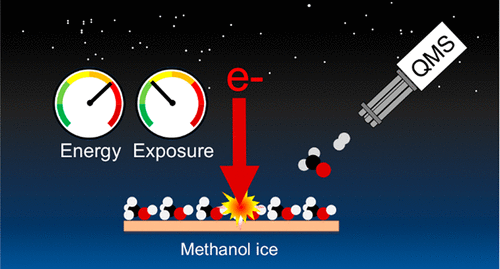当前位置:
X-MOL 学术
›
ACS Earth Space Chem.
›
论文详情
Our official English website, www.x-mol.net, welcomes your
feedback! (Note: you will need to create a separate account there.)
Electron-Induced Processing of Methanol Ice
ACS Earth and Space Chemistry ( IF 2.9 ) Pub Date : 2021-01-15 , DOI: 10.1021/acsearthspacechem.0c00250 Fabian Schmidt 1 , Petra Swiderek 1 , Jan H. Bredehöft 1
ACS Earth and Space Chemistry ( IF 2.9 ) Pub Date : 2021-01-15 , DOI: 10.1021/acsearthspacechem.0c00250 Fabian Schmidt 1 , Petra Swiderek 1 , Jan H. Bredehöft 1
Affiliation

|
The formation of methane (CH4), formaldehyde (H2CO), ethylene glycol (HOCH2CH2OH), methoxymethanol (CH3OCH2OH), dimethyl ether (CH3OCH3), and ethanol (CH3CH2OH) upon electron irradiation of condensed multilayer adsorbates of CH3OH as a model of cosmic CH3OH ice has been monitored by the combined use of electron-stimulated and thermal desorption experiments. The energy-dependent relative yields of all products were measured between 2.5 and 20 eV, and the reaction mechanisms of product formation were deduced. The energy dependences of the yields of HOCH2CH2OH, CH3OCH2OH, CH3OCH3, and CH3CH2OH agree closely with their threshold at the lowest electronic excitation energy of CH3OH. The formation of these products is consequently ascribed to the reactions of radicals formed by the dissociation of neutral electronically excited states and, at higher energy, also by ionization and subsequent proton transfer to an adjacent CH3OH. These electron–molecule interactions also can contribute to the nonresonant formation of H2CO and CH4; these latter products are also produced through resonances around 4 eV reported previously from anion electron-stimulated desorption (ESD) experiments and around 13 eV seen earlier in the energy-dependent yield of carbon monoxide (CO). The present results constitute the most complete data set on the energy dependence of product formation during low-energy electron exposure of condensed CH3OH so far. They provide a comprehensive picture of the reactions triggered by electron impact with energies in the range between 2.5 and 20 eV as representative of low-energy secondary electrons that are released from condensed material, for instance, under the effect of cosmic radiation.
中文翻译:

电子诱导的甲醇冰处理
甲烷(CH 4),甲醛(H 2 CO),乙二醇(HOCH 2 CH 2 OH),甲氧基甲醇(CH 3 OCH 2 OH),二甲醚(CH 3 OCH 3)和乙醇(CH 3 CH 2 OH)CH时的冷凝多层吸附物的电子照射3 OH作为CH宇宙的模型3OH冰已通过结合使用电子刺激实验和热解吸实验进行了监测。测得所有产物的能量依赖性相对产率在2.5和20eV之间,并推导了产物形成的反应机理。HOCH的产率的能量依赖性2 CH 2 OH,CH 3 OCH 2 OH,CH 3 OCH 3,和CH 3 CH 2 OH与CH的最低电子激发能量它们的阈值密切同意3哦。因此,这些产物的形成归因于由中性电子激发态的解离形成的自由基的反应,并且在更高的能量下,还由于离子化和随后的质子转移到相邻的CH 3 OH而形成自由基。这些电子-分子相互作用也可能导致H 2 CO和CH 4的非共振形成。后一种产物也是通过阴离子电子刺激解吸(ESD)实验先前报道的大约4 eV的共振产生的,以及较早时能量依赖性一氧化碳(CO)产生的13 eV的共振产生的。目前的结果构成了关于冷凝CH 3的低能电子暴露过程中产物形成的能量依赖性的最完整数据集到目前为止。它们提供了能量在2.5到20 eV之间的电子撞击引发的反应的全面描述,代表了从凝结材料释放出的低能二次电子,例如在宇宙辐射的作用下。
更新日期:2021-02-18
中文翻译:

电子诱导的甲醇冰处理
甲烷(CH 4),甲醛(H 2 CO),乙二醇(HOCH 2 CH 2 OH),甲氧基甲醇(CH 3 OCH 2 OH),二甲醚(CH 3 OCH 3)和乙醇(CH 3 CH 2 OH)CH时的冷凝多层吸附物的电子照射3 OH作为CH宇宙的模型3OH冰已通过结合使用电子刺激实验和热解吸实验进行了监测。测得所有产物的能量依赖性相对产率在2.5和20eV之间,并推导了产物形成的反应机理。HOCH的产率的能量依赖性2 CH 2 OH,CH 3 OCH 2 OH,CH 3 OCH 3,和CH 3 CH 2 OH与CH的最低电子激发能量它们的阈值密切同意3哦。因此,这些产物的形成归因于由中性电子激发态的解离形成的自由基的反应,并且在更高的能量下,还由于离子化和随后的质子转移到相邻的CH 3 OH而形成自由基。这些电子-分子相互作用也可能导致H 2 CO和CH 4的非共振形成。后一种产物也是通过阴离子电子刺激解吸(ESD)实验先前报道的大约4 eV的共振产生的,以及较早时能量依赖性一氧化碳(CO)产生的13 eV的共振产生的。目前的结果构成了关于冷凝CH 3的低能电子暴露过程中产物形成的能量依赖性的最完整数据集到目前为止。它们提供了能量在2.5到20 eV之间的电子撞击引发的反应的全面描述,代表了从凝结材料释放出的低能二次电子,例如在宇宙辐射的作用下。











































 京公网安备 11010802027423号
京公网安备 11010802027423号